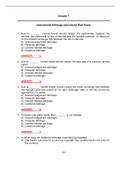Other
Practice Questions-International Financial Management Jeff Madura 10th Edition Chapter 7-10
- Course
- Institution
- Book
This file includes practice questions for International Financial Management Jeff Madura 10th Edition Chapter 7-10 inclusive of True or False and Multiple Choice Questions.
[Show more]



